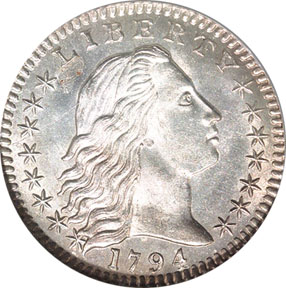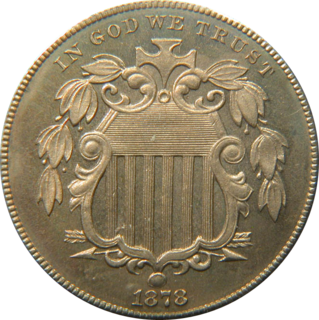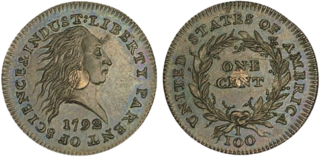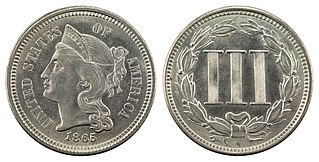
The cent, the United States one-cent coin, often called the "penny", is a unit of currency equaling one one-hundredth of a United States dollar. It has been the lowest face-value physical unit of U.S. currency since the abolition of the half-cent in 1857. The first U.S. cent was produced in 1787, and the cent has been issued primarily as a copper or copper-plated coin throughout its history.

1943 steel cents are U.S. one-cent coins that were struck in steel due to wartime shortages of copper. The Philadelphia, Denver, and San Francisco mints each produced these 1943 Lincoln cents. The unique composition of the coin has led to various nicknames, such as wartime cent, steel war penny, zinc cent and steelie. The 1943 steel cent features the same Victor David Brenner design for the Lincoln cent which had been in use since 1909.

A nickel is a five-cent coin struck by the United States Mint. Composed of cupronickel, the piece has been issued since 1866. Its diameter is 0.835 inches (21.21 mm) and its thickness is 0.077 inches (1.95 mm).

The dime, in United States usage, is a ten-cent coin, one tenth of a United States dollar, labeled formally as "one dime". The denomination was first authorized by the Coinage Act of 1792.

The two-cent piece was produced by the Mint of the United States for circulation from 1864 to 1872 and for collectors in 1873. Designed by James B. Longacre, there were decreasing mintages each year, as other minor coins such as the nickel proved more popular. It was abolished by the Mint Act of 1873.

The Liberty Head nickel, sometimes referred to as the V nickel because of its reverse design, is an American five-cent piece. It was struck for circulation from 1883 until 1912, with at least five pieces being surreptitiously struck dated 1913. The obverse features a left-facing image of the goddess of Liberty.

The United States three cent piece was a unit of currency equaling 3⁄100 of a United States dollar. The mint produced two different three-cent coins for circulation: the three-cent silver and the three-cent nickel. Additionally, a three-cent bronze coin was made as a pattern in 1863. During the period from 1865 to 1873, both coins were minted, albeit in very small quantities for the silver three-cent piece.

The half dime, or half disme, was a silver coin, valued at five cents, formerly minted in the United States.
The British farthing was a British coin worth a quarter of an old penny. It ceased to be struck after 1956 and was demonetised from 1 January 1961.

The Indian Head cent, also known as an Indian Head penny, was a one-cent coin ($0.01) produced by the United States Bureau of the Mint from 1859 to 1909. It was designed by James Barton Longacre, the Chief Engraver at the Philadelphia Mint.

The United States large cent was a coin with a face value of 1/100 of a United States dollar. Its nominal diameter was 11⁄8 inch (28.57 mm). The first official mintage of the large cent was in 1793, and its production continued until 1857, when it was officially replaced by the modern-size one-cent coin.

The Flying Eagle cent is a one-cent piece struck by the Mint of the United States as a pattern coin in 1856 and for circulation in 1857 and 1858. The coin was designed by Mint Chief Engraver James B. Longacre, with the eagle in flight based on the work of Longacre's predecessor, Christian Gobrecht.

The Shield nickel was the first United States five-cent piece to be made out of copper-nickel, the same alloy of which American nickels are struck today. Designed by James B. Longacre, the coin was issued from 1866 until 1883, when it was replaced by the Liberty Head nickel. The coin takes its name from the motif on its obverse, and was the first five-cent coin referred to as a "nickel"—silver pieces of that denomination had been known as half dimes.

The Silver center cent is an American pattern coin produced by the United States Mint in 1792. As a precursor to the large cent it was one of the first coins of the United States and an early example of a bimetallic coin. Only 12 original examples are known to exist, of which one is located in the National Numismatic Collection at the Smithsonian Institution. Two more specimens exist but contain fabricated plugs added after minting.

The 1974 aluminum cent was a one-cent coin proposed by the United States Mint in 1973. It was composed of an alloy of aluminum and trace metals, and it was intended to replace the predominantly copper–zinc cent due to the rising costs of coin production in the traditional bronze alloy. Of the 1,571,167 coins struck in anticipation of release, none were released into circulation. To encourage congressional support for the new alloy, the Mint distributed several examples to US Congressmen. When the proposed aluminum cent was rejected, the Mint recalled and destroyed those coins. However, despite the recall, a few aluminum cents were not returned to the Mint, and those coins may remain at large. One example was donated to the Smithsonian Institution, while another was alleged to have been found by Albert P. Toven, a US Capitol Police Officer. A 1974-D specimen was found in January 2014 by Randall Lawrence, who said it was a retirement gift to his father, Harry Edmond Lawrence, who was Deputy Superintendent at the Denver Mint. Randall planned on selling it in a public auction, but the Mint demanded its return, saying that the coin was never authorized for release and therefore remains U.S. Government property. Lawrence ultimately surrendered the coin when the Mint showed that the aluminum cent had never been authorized to be struck in Denver, and there was no evidence that the coin had been a gift of any kind.

The half union was a United States pattern coin with a face value of fifty U.S. Dollars. It is often thought of as one of the most significant and well-known patterns in the history of the U.S. Mint. The basic design, featuring Liberty on the obverse, was slightly modified from the similar $20 "Liberty Head" Double Eagle, which was designed by James B. Longacre and minted from 1849 to 1907.
The ten-cent coin is the lowest-denomination circulating coin of the Hong Kong dollar. With a diameter of 17.5 mm and a mass of 1.85 g it is also the smallest in size and weight. It is the oldest coin denomination to still be in circulation in Hong Kong. Since its first issue in 1863, there has only been one period (1942–1947) where the coin was not in use.

The copper-nickel three-cent piece, often called a three-cent nickel piece or three-cent nickel, was designed by US Mint Chief Engraver James B. Longacre and struck by the United States Bureau of the Mint from 1865 to 1889. It was initially popular, but its place in commerce was supplanted by the five-cent piece, or nickel.

The two-cent billon was a pattern US coin struck in 1836 and initially proposed as part of the Act of January 13, 1837. Versions exist with either a reeded edge and coin orientation or a plain edge and medal orientation; however, those with the former tend to be original strikes, whereas the latter are always proof restrikes.

The ring cent or holey cent was a one-cent pattern coin first struck in various compositions and designs between 1850 and 1851 as part of an experiment on producing a cent with a reduced weight and diameter, as the rising price of copper had caused cents to cost more than their face value to produce. Many varieties exist, with differing designs as well as differing compositions, including billon (standard), aluminum, copper, cupronickel, nickel silver, nickel, silver, and white metal.



















